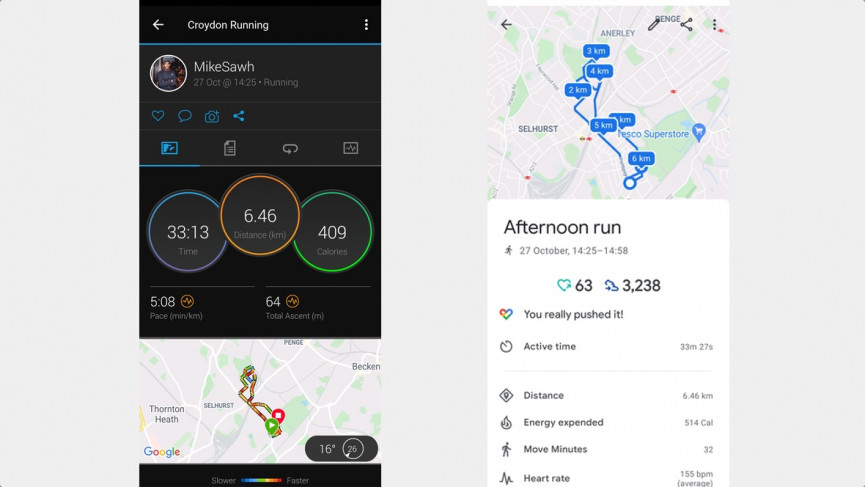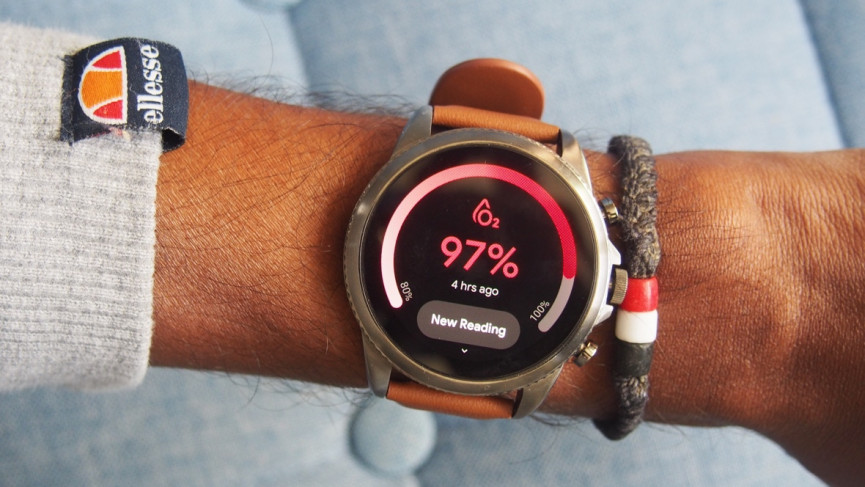
- Typically great Fossil look
- Zippy performance
- Reliable real-time heart rate
- Improved sports tracking
- Wear OS 2 just isn't great
- Battery life bad with always-on mode
- Sleep data didn't sync to Google Fit
The Fossil Gen 6 lands at an exciting time for Wear OS. The platform is undergoing a regeneration, with the upgraded Wear OS 3 set to bring better apps and improved performance.
While Gen 5 was about adding more smartwatch features and improving iPhone support, Gen 6 amps up performance thanks to Qualcomm's latest Snapdragon Wear 4100+ processor.
The Fossil Gen 6 will be upgraded to Wear OS 3 built by Google and Samsung. Frustratingly, that won't be until 2022.
Fossil has got a lot of things right with its smartwatches, with fashion-forward design and adding in some of its software flourishes to Google's OS. So is the Fossil Gen 6 a smartwatch great even without new Wear? We've been living with it to find out. Here's our comprehensive verdict.
Price and alternatives
It's around the price of the Apple Watch SE (2nd Gen), Samsung Galaxy Watch 5, and the Fitbit Versa 4.
At the same price, it's hard to offer a single reason to choose the Gen 6 on the promise of Wear OS 3 over the Galaxy Watch 5 with the new OS already in fine fetter.
Likewise, the Amazfit GTR 3 Pro and Huawei Watch 3 are all great alternatives at a lower price – and all have fewer question marks.
Design and screen
Wareable
Fossil has made some of the best-looking smartwatches going, let alone Wear OS models, and that thankfully doesn't change with its Gen 6 watch. It's another stylish number, and there are options here for both men and women too.
Size-wise, you've got your pick of 42mm or 44mm stainless steel cases, with a range of strap materials, looks, and colors to pick from.
We had the larger 44mm smoke stainless steel version, which partners up that stainless steel case with an interchangeable 22mm metal strap.
That metal strap needed a few links taken out of it to fit our slender wrists, so we opted for a third-party leather strap (pictured). Overall, it and wasn't too thick or bulky to wear even with slender wrists.
Like previous Fossil watches there are two pushers and crowns on the right side of the case.
The top pusher gets you to Fossil's new wellness screen where you can see data like heart rate, blood oxygen, and sleep all in one place.
The bottom pusher is set to offer quick access to Google Pay, but you do still have the ability to adjust what these pushers can quickly launch.
The crown that sits between them can twist, letting you scroll through messages and screens and is also used to launch the app menu screen and Google Assistant.
Wareable
Front and center is a 1.28-inch, 416 x 416 AMOLED touchscreen display, which matches the screen packed into Fossil's Gen 5 watches for size and resolution.
It's a good quality AMOLED screen with accurate colors, deep blacks, and a good maximum brightness.
Visibility indoors is solid and it doesn't struggle in bright outdoor light when some AMOLED screens often do.
You do have the option to use it in always-on mode, which slightly dims the screen to make sure you can see and keep an eye on the time.
Fossil hasn't budged on the water resistance rating here either, slapping its Gen 6 watch with the same 3ATM rating, which means it is safe to wear in the shower and to go swimming with it up to 30 metres depth.
Wear OS and smartwatch features
Wareable
So there's a lot to talk about here on the software front. We'll start by saying that it currently runs on Wear OS 2 and will be updated to Wear OS 3, which is currently only available on the Samsung Galaxy Watch 4. It won't happen until sometime in 2022.
Right now, it's familiar Wear, though Fossil has added some small software extras. There's nothing groundbreaking, but it helps to make this feel more like a Fossil watch and not just another Wear OS watch.
You get plenty of watch faces and the ability to create customized watch face looks plus there's the new wellness screen we mentioned earlier. Fossil has included an app for Amazon Alexa integration, but it's currently not accessible.
Outside of that, it's very much the version of Wear we know and (don't) love.
You've got that same app menu screen, a stream of notifications when you swipe up from the main watch screen and Tiles (widgets) when you swipe left from that same screen.
There's a microphone and speaker to make calls when paired to your phone via Bluetooth and with YouTube Music and Spotify support, offline music support is back too.
Wareable
Our experience on the whole when paired to an Android phone was fine.
There are elements of Wear we don't mind like music controls and notification support, but as a package, it's still a little too clunky in places for our liking.
The screen dedicated to Google Assistant features seems like wasted space and the app screen could do with moving to a new look that makes it easier to find what you're looking for.
It's not clear if Wear OS 3 will entirely mirror what we experienced on the Galaxy Watch 4, but it's clear to us that some of the newer UI elements, improved menu screens and rebuilt apps we've experienced on Samsung's latest watch are needed here.
Wareable
While we haven't had massive issues with the way Fossil's smartwatches have run in the past, the Gen 6 has been updated to pack Qualcomm's latest Snapdragon 4100+ platform, which is said to offer a 30% boost in performance on Gen 5.
That's accompanied by 1GB of RAM and 8GB of storage.
Swiping through screens and launching apps didn't feel noticeably more snappy than Gen 5 in our time with it, but that 4100+ integration crucially gives it the performance foundations to run on Wear OS 3, which is the key here.
As a smartwatch, the Gen 6 is screaming out for new Wear. There are still a lot of unknowns as far as how the new Wear will look on a Fossil smartwatch when it lands in 2022.
We hope that Fossil continues being able to add its own software extras, but it's hard to know what we can expect from a Gen 6 watch with Wear OS 3.
Health and fitness tracking
Wareable
It's fair to say we haven't had the greatest experience tracking our fitness on Fossil's watches in the past. Ultimately, they've never felt the best suited, yet Fossil continues to add more health and fitness-centric features.
You can track indoor and outdoor workouts, with the accelerometer handling the former, and the built-in GPS handling outdoor activities.
There's an optical heart rate monitor to continuously track heart rate as well as during exercise.
There's now a new SpO2 sensor to track blood oxygen, though like many smartwatches it isn't designed for medical use.
You'll use Google's suite of Fit apps to primarily track things like steps, exercise, and heart rate, but you do have access to third party Wear OS apps with the likes of Cardiogram, and Nike Run Club already preloaded.
We primarily focused on using Google Fit, which does now offer to display more data and still places a big emphasis on collecting Heart and Move Points.
Wareable
GPS run tracking compared: Fossil Gen 6 (left) and Garmin Enduro (right)
When we took the Gen 6 out for a run, it did lock on nice and quickly to a GPS signal and offers metrics basics like distance, pace, calorie burn, and heart rate. We found distance tracking on 30-40 minutes runs matched up with a Garmin running watch and average pace wasn't far off either.
It didn't do as well tracking heart rate with average heart rate generally coming in 10bpm lower than a Garmin HRM-Pro chest strap monitor. Maximum heart rate was also significantly lower than the chest strap readings as well.
Wareable
Running heart rate compared: Fossil Gen 6 (left) and Garmin HRM-Pro chest strap monitor (right)
That heart rate monitor fared better indoors for rowing machine workouts at lower intensities, with the Gen 6 recording a one bpm difference on average and maximum heart rate readings against a chest strap in our rowing sessions.
Wareable
Indoor rowing heart rate compared: Fossil Gen 6 (left) and Garmin HRM-Pro chest strap monitor (right)
When turning to the Gen 6 for activity tracking, you do have a dedicated watch screen to check step counts and expand to see the distance covered, your Move Minutes and Heart Points.
We found step counts were largely in line with Fitbit and Garmin's tracking, but it doesn't do a huge amount as far as keeping your motivated to move regularly during the day.
Wareable
You can track sleep here, though we struggled to sync sleep data to the Google Fit app over from the watch. The sleep-tracking data wasn't hugely accurate either.
We found it was usually found it 1-2 hours off from sleep duration tracking on a Fitbit though it was impossible to dig deeper into the data without that data syncing over to the app.
Continuous heart rate monitoring and real-time heart rate monitoring have their good and bad moments. In general, we found real-time measurements matched up with a chest strap and reliable resting heart rate monitoring on a Garmin.
A closer look at the continuous data and the story of our heart rate is very different. Resting heart rate was significantly higher than a Garmin watch we've come to find offers reliable resting heart rate data.
Wareable
Continuous heart rate compared: Fossil Gen 6 (left) and Garmin Enduro (right)
Monitoring blood oxygen is the big new sensor addition here, letting you take on-the-spot readings, which are stored in the Vitals section of the Google Fit app. It takes 25 seconds to take a reading and we found readings were at most 1% off a dedicated pulse oximeter. As a reminder though, these readings aren't offering serious health insights.
Wareable
Overall it feels like there are improvements in places but ultimately you're not going to turn to this watch for serious health and fitness tracking.
Now it's all about Google pulling it all together in a way that makes it much easier to absorb and understand.
This is where the influence of Fitbit in Wear OS 3 could be a major factor in improving what it's like to use Wear OS smartwatch for tracking your health and fitness.
Battery life
Wareable
Whichever model of the Gen 6 you go for, you can expect the same sort of battery life. That's 24 hours according to Fossil, with the addition of some smart battery modes to make sure you get a day. That's the same sort of battery life that was touted for the Gen 5, and we'd still say it's just good for a day.
We found with the screen set to always-on and using core features like notifications and sports tracking, the battery dropped by about 10% an hour. With just over 30 minutes of using the GPS for running, the battery dropped over 10%.
Those extended and time only battery modes serve to make sure you do get 24 hours, but will restrict some features in the process. We've seen other Wear OS watches like the TicWatch Pro 3 manage to push battery performance further, so it's disappointing to see no real progress made here.
Fossil has added a new fast-charging feature that does get you from 0-80% battery from just over a 30-minute charge. It uses the same style of white charging cradle as previous Fossil watches, which does magnetically snap to the back to make sure it stays put.
How we test
